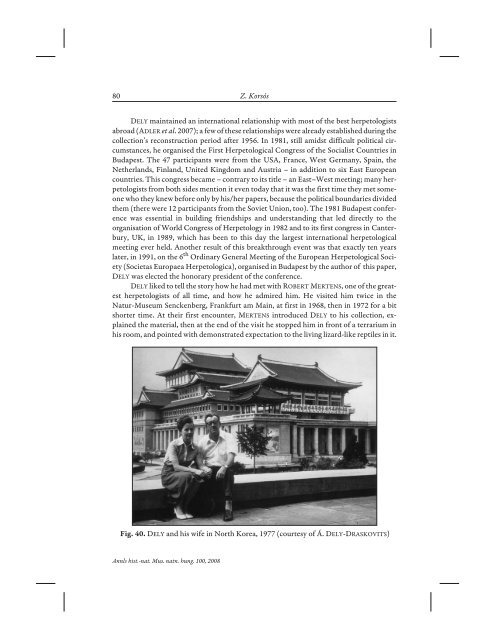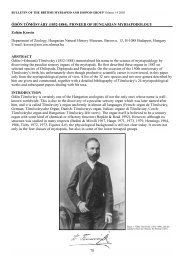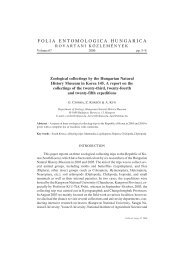History of the Herpetological Collection of the ... - Korsós Zoltán
History of the Herpetological Collection of the ... - Korsós Zoltán
History of the Herpetological Collection of the ... - Korsós Zoltán
Create successful ePaper yourself
Turn your PDF publications into a flip-book with our unique Google optimized e-Paper software.
80 Z. Korsós<br />
DELY maintained an international relationship with most <strong>of</strong> <strong>the</strong> best herpetologists<br />
abroad (ADLER et al. 2007); a few <strong>of</strong> <strong>the</strong>se relationships were already established during <strong>the</strong><br />
collection’s reconstruction period after 1956. In 1981, still amidst difficult political circumstances,<br />
he organised <strong>the</strong> First <strong>Herpetological</strong> Congress <strong>of</strong> <strong>the</strong> Socialist Countries in<br />
Budapest. The 47 participants were from <strong>the</strong> USA, France, West Germany, Spain, <strong>the</strong><br />
Ne<strong>the</strong>rlands, Finland, United Kingdom and Austria – in addition to six East European<br />
countries. This congress became – contrary to its title – an East–West meeting; many herpetologists<br />
from both sides mention it even today that it was <strong>the</strong> first time <strong>the</strong>y met someone<br />
who <strong>the</strong>y knew before only by his/her papers, because <strong>the</strong> political boundaries divided<br />
<strong>the</strong>m (<strong>the</strong>re were 12 participants from <strong>the</strong> Soviet Union, too). The 1981 Budapest conference<br />
was essential in building friendships and understanding that led directly to <strong>the</strong><br />
organisation <strong>of</strong> World Congress <strong>of</strong> Herpetology in 1982 and to its first congress in Canterbury,<br />
UK, in 1989, which has been to this day <strong>the</strong> largest international herpetological<br />
meeting ever held. Ano<strong>the</strong>r result <strong>of</strong> this breakthrough event was that exactly ten years<br />
later, in 1991, on <strong>the</strong> 6 th Ordinary General Meeting <strong>of</strong> <strong>the</strong> European <strong>Herpetological</strong> Society<br />
(Societas Europaea Herpetologica), organised in Budapest by <strong>the</strong> author <strong>of</strong> this paper,<br />
DELY was elected <strong>the</strong> honorary president <strong>of</strong> <strong>the</strong> conference.<br />
DELY liked to tell <strong>the</strong> story how he had met with ROBERT MERTENS, one <strong>of</strong> <strong>the</strong> greatest<br />
herpetologists <strong>of</strong> all time, and how he admired him. He visited him twice in <strong>the</strong><br />
Natur-Museum Senckenberg, Frankfurt am Main, at first in 1968, <strong>the</strong>n in 1972 for a bit<br />
shorter time. At <strong>the</strong>ir first encounter, MERTENS introduced DELY to his collection, explained<br />
<strong>the</strong> material, <strong>the</strong>n at <strong>the</strong> end <strong>of</strong> <strong>the</strong> visit he stopped him in front <strong>of</strong> a terrarium in<br />
his room, and pointed with demonstrated expectation to <strong>the</strong> living lizard-like reptiles in it.<br />
DELY and his wife in North Korea, 1977 (courtesy <strong>of</strong> Á. DELY-DRASKOVITS)<br />
Annls hist.-nat. Mus. natn. hung. 100, 2008




